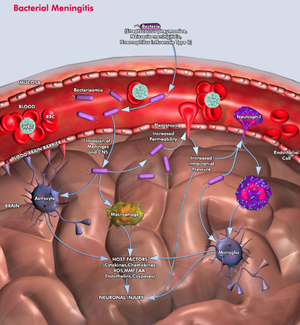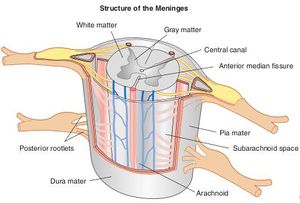Neisseria meningitidis causing meningococcal meningitis
Introduction

Neisseria meningitidis, gram-negative diplococci that cause meningococcal meningitis (magnified x 33000) (http://www.dailymail.co.uk/sciencetech/article-2197533/As-pretty-picture-lot-deadly--Killer-diseases-youve-seen-before.html).
By Kelsey McMurtry
Neisseria meningitidis is a gram-negative diplococci of the Proteobacteria phylum (7). This bacterium specifically causes disease in humans (1), and is one of the three main bacteria that causes acute bacterial meningitis, along with Streptococcus pneumoniae and Haemophilus influenzae. Of the forms of acute bacterial meningitis, Neisseria meningitidis causes meningococcal meningitis, which is among the top 10 causes of death due to infection across the globe, where one-third to half of people who survive the infection deal with permanent physical or mental side effects of the disease (2). These side effects, also known as sequelae, can include chronic fatigue and insomnia, which were symptoms found in those who survived epidemic meningococcal meningitis (2). In fact, these symptoms closely reflected those of individuals who experienced post-traumatic stress disorder following survival of septicaemia and septic shock (2). These two conditions involve the bacterium infiltrating the bloodstream, which is normally a sterile environment.
What is bacterial meningitis?
According to A. Chaudhuri, bacterial meningitis is defined as the "leptomeningeal inflammation resulting from infection of the pia" (2). This means that the layers that surround the central nervous system- the meninges- are inflamed. The meninges are composed of the of pia, the arachnoid, and the subarachnoid space (see figure). Many cases of meningitis involve the spread of bacteria from an infection in a completely different part of the body by traveling through the bloodstream to the brain and spinal cord. However, bacteria have been also known to spread throughout the body from a significant blow to the head, or from an infection initially located in the ear, nose, or teeth. Unfortunately, as the disease persists, the brain begins to swell and promotes the possibility of bleeding.
Pathophysiology of bacterial meningitis
As a rapidly progressive disorder, meningococcal meningitis involves Neisseria meningitidis invading the subarachnoid space of the brain, where the body responds with inflammation of the meninges due to bacterial infection. After the bacteria replicate in the bloodstream, they travel through the blood and sometimes cross the blood-brain barrier and take over the subarachnoid space. While in the bloodstream, white blood cells attack Neisseria meningitidis, but unfortunately once the bacteria enter the subarachnoid space, the host's defense network is unable to control the infection developing in the cerebrospinal fluid (CSF) because the presence of safeguards (local antibodies and complement activity) is lacking in the area. As the numbers of bacteria and white blood cells increase in the CSF, a local inflammatory response is induced in the subarachnoid space due to the creating and releasing of inflammatory mediators. These nasty compounds cause an increase in the number of white blood cells within the CSF and increase the accessibility of the blood-brain barrier, a key ingredient to the bacterial meningitis infection. In response to the accessibility of a typically sterile environment to pathogens, mediators (including liposaccharides and cytotoxin-engaging receptors, including what are called Toll-like receptors) of endothelial cells activate downstream cascades that release white-blood cell precursors and other immune cell responses. This allows for white blood cells (specifically neutrophils, as shown in the figure) to move across the blood-brain barrier (6).
Although the host can show signs of symptoms such as confusion, stupor, coma, and seizures that correlate with bacterial meningitis, these conditions are not directly caused by bacterial invasion because the bacteria cannot invade the tissue located underneath the pia. Accessing the subpial tissue is a chemical response induced by proinflammatory cytokines, which are small signaling molecules used for cell signaling, that are released in response to the bacterial invasion and the breaking down of cells within the subarachnoid space (please refer to the figure for further explanation and understanding).
Section 2
Neisseria meningitidis has the greatest outbreak potential of the three bacteria causing acute bacterial meningitis, and regularly causes outbreaks in sub-Saharan Africa.
Section 3
Include some current research in each topic, with at least one figure showing data.
Conclusion
Overall paper length should be 3,000 words, with at least 3 figures.
References
(6) "Bacterial Meningitis." Qiagen: Sample & Assay Technologies. 2013. Web. 22 Apr. 2013. <http://www.qiagen.com/products/genes%20and%20pathways/Pathway%20Details.aspx?pwid=50>.
(9) Bertrand, Sophie, Francoise Carion, Rene Wintjens, Vanessa Mathys, and Raymond Vanhoof. "American Society for MicrobiologyAntimicrobial Agents and Chemotherapy." Evolutionary Changes in Antimicrobial Resistance of Invasive Neisseria Meningitidis Isolates in Belgium from 2000 to 2010: Increasing Prevalence of Penicillin Nonsusceptibility. Web. 22 Apr. 2013. <http://aac.asm.org/content/56/5/2268.full.pdf html>.
(2) Chaudhuri, A. "Adjunctive Dexamethasone Treatment in Acute Bacterial Meningitis." The Lancet Neurology 3.1 (2004): 54-62. Print.
(11) Feavers, Ian M., and Mariagrazia Pizza. "Meningococcal Protein Antigens and Vaccines." Elsevier (2009): B42-50. ScienceDirect. Web. 15 Apr. 2013. <www.elsevier.com/locate/vaccine>.
(3) Johnson, Steven, Lionel Tan, Stijn Van Der Veen, Joseph Caesar, Elena Goicoechea De Jorge, Rachel J. Harding, Xilian Bai, Rachel M. Exley, Philip N. Ward, Nicola Ruivo, Kaushali Trivedi, Elspeth Cumber, Rhian Jones, Luke Newham, David Staunton, Rafael Ufret-Vicenty, Ray Borrow, Matthew C. Pickering, Susan M. Lea, and Christoph M. Tang. "Design and Evaluation of Meningococcal Vaccines through Structure-Based Modification of Host and Pathogen Molecules." PLOS Pathogens 8.10 (2012): 1-13. PLOS. Web. 16 Apr. 2013. <www.plospathogens.org>.
(1) McIntyre, Peter B., Katherine L. O'Brien, Brian Greenwood, and Diederik Van De Beek. "Effect of Vaccines on Bacterial Meningitis Worldwide." The Lancet 380 (2012): 1703-711. Print.
(7)"Neisseria Meningitidis." Wikipedia. Wikimedia Foundation, 22 Apr. 2013. Web. 22 Apr. 2013. <http://en.wikipedia.org/wiki/Neisseria_meningitidis>.
(10) Peterson, D. C., G. Arakere, J. Vionnet, P. C. McCarthy, and W. F. Vann. "Characterization and Acceptor Preference of a Soluble Meningococcal Group C Polysialyltransferase." Journal of Bacteriology 193.7 (2011): 1576-582. Print.
(4) "Progress and Challenges in Bacterial Meningitis." The Lancet 380 (2012): 1623-624. Web. 15 Apr. 2013. <www.thelancet.com>.
(8) Van De Beek, Diederik, Matthijs C. Brouwer, Guy E. Thwaites, and Allan R. Tunkel. "Advances in Treatment of Bacterial Meningitis." The Lancet 380 (2012): 1693-702. 10 Nov. 2012. Web. 14 Apr. 2013.
(5) "What Are the Facts About Meningitis?" Meningitis Symptoms. Web. 13 Apr. 2013. <http://www.chacha.com/gallery/4869/what-are-the-facts-about-meningitis/46227>.
Edited by student of Joan Slonczewski for BIOL 238 Microbiology, 2009, Kenyon College.


